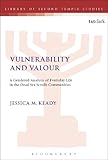Vulnerability and valour : a gendered analysis of everyday life in the Dead Sea Scrolls communities / by Jessica M. Keady.
Material type: TextSeries: Library of Second Temple studies ; 91.Publisher: New York : Bloomsbury Academic, 2017Description: 1 online resource (vii, 204 pages)Content type:
TextSeries: Library of Second Temple studies ; 91.Publisher: New York : Bloomsbury Academic, 2017Description: 1 online resource (vii, 204 pages)Content type: - 9780567672254
- 0567672255
- 9780567672261
- 0567672263
- 9780567672278
- 0567672271
- 296.1/55 23
- BM702 .K424 2017eb
- online - EBSCO
| Item type | Current library | Call number | URL | Status | Notes | Barcode | |
|---|---|---|---|---|---|---|---|
 eBook
eBook
|
Biblioteca "Angelicum" Pont. Univ. S.Tommaso d'Aquino Nuvola online | online - EBSCO (Browse shelf(Opens below)) | Online access | Not for loan (Accesso limitato) | Accesso per gli utenti autorizzati / Access for authorized users | (ebsco)1447696 |
Print version record.
Introduction -- The debate about purity and impurity in the Dead Sea Scrolls -- Purity and impurity in the Dead Sea Scrolls: masculinity, embodiment and the everyday as methodological tools -- Masculinity studies and the men of the Dead Sea Scrolls communities -- Thinking beyond the abstract : towards an embodied reading of purity -- Everyday living and the constructions of spatial privacy in the Dead Sea Scrolls communities focusing on the Temple Scroll and the Rule of the Congregation -- Conclusion : beyond an abstract reading of purity.
Jessica M. Keady uses insights from social science and gender theory to shed light on the Dead Sea Scrolls and the community at Qumran. Through her analysis Keady shows that it was not only women who could be viewed as an impure problem, but also that men shared these characteristics as well. The first framework adopted by Keady is masculinity studies, specifically Raewyn Connell's hegemonic masculinity, which Keady applies to the Rule of the Community (in its 1QS form) and the War Scroll (in its 1QM form), to demonstrate the vulnerable and uncontrollable aspects of ordinary male impurities. Secondly, the embodied and empowered aspects of impure women are revealed through an application of embodiment theories to selected passages from 4QD (4Q266 and 4Q272) and 4QTohorot A (4Q274). Thirdly, sociological insights from Susie Scott's understanding of the everyday - through the mundane, the routine and the breaking of rules - reveal how impurity disrupts the constructions of daily life. Keady applies Scott's three conceptual features for understanding the everyday to the Temple Scroll (11QTa) and the Rule of the Congregation (1QSa) to demonstrate the changing dynamics between ordinary impure males and impure females. Underlying each of these three points is the premise that gender and purity in the Dead Sea Scrolls communities are performative, dynamic and constantly changing


